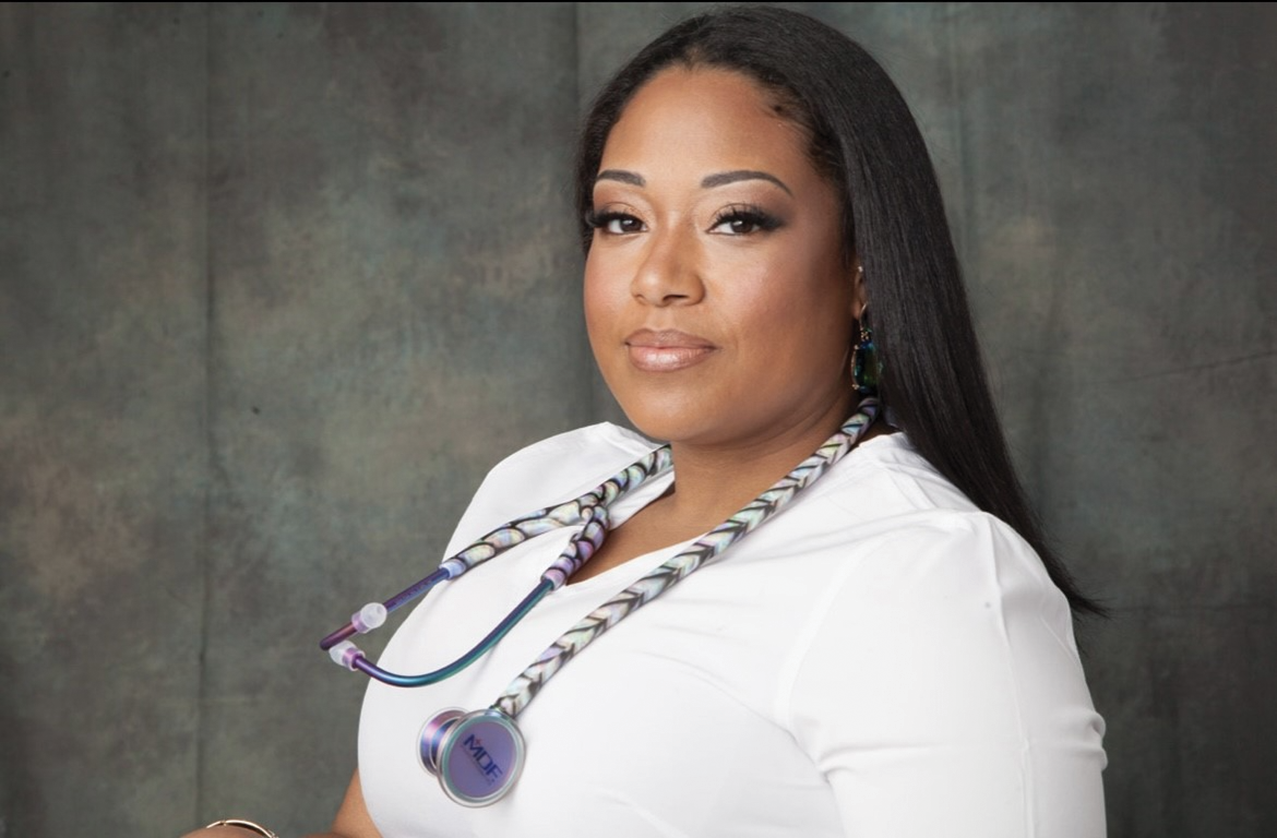The story of a nurse who overcame assumptions, bias, and challenges
- Media and healthcare organizations portray fully able-bodied individuals as the norm for performing the nursing role.
- Frequent interaction with the healthcare system might inspire someone with a physical disability to pursue a nursing career.
- Andrea Dalzell, MSN, RN, shares her story of applying for and attending nursing school.
A personal experience with a transformative nurse can provide inspiration to choose a nursing career. For example, frequent interaction with the healthcare system might motivate some with a physical disability (PD) to aspire to become a nurse. However, media and practice frequently portray fully able-bodied individuals as the norm for performing the rigorous requirements of inpatient, direct-care nursing. In nursing education, nurse educators, clinical decision makers, and practicing nurses reinforce this expectation; they frequently believe that the limitations associated with a PD are incompatible with safe nursing practice. They might not consider how the personal experiences of an individual with a PD might make them an excellent nurse.
The literature on disability in nurses has increased over the past few decades; however, much of the research focuses on nurses becoming disabled as the result of a workplace injury. Studies in nursing education are even more limited, and they typically focus on learning disabilities. Marks and Sisirak provide an extensive literature review and discussion on this topic.
The Americans with Disabilities Act (ADA) of 1990 and the ADA Amendments Act of 2008 receive credit for advancing the rights of people with disabilities in the United States, including employment rights. ADA requires employers to provide accurate descriptions of the essential functions for job classifications. For example, the technical standards for an inpatient, direct-care nursing position might require standing and walking for up to 12 hours, unrestricted mobility to care for patients in hospital beds, and full participation during patient emergencies. Because traditional nursing education focuses on inpatient nursing practice and relies heavily on hospitals for clinical experiences, nursing programs integrated these technical standards into admissions criteria. The law, designed to prevent blanket discrimination against people with disabilities, resulted in unintended consequences; it became a barrier for people with a PD to access a nursing career.
Nurses work in diverse settings. Any applicant who doesn’t meet a specific position’s requirements (including knowledge, skills, or other experiences, which are the focus of the ADA) wouldn’t be qualified. Therefore, nursing education doesn’t need to serve as the gatekeeper, and academically qualified students with a PD can be included, with appropriate accommodations, for clinical experiences. When nursing addresses diversity, equity, and inclusion in the profession, people with a PD frequently aren’t considered. This results in a lack of role models and encouragement for people with a PD to pursue nursing careers.
In a powerful rejection of the barriers that prevent people with a PD from entering nursing education, Andrea’s story, which follows, describes how a woman who uses a wheelchair overcame several obstacles to become a professional nurse. Her experience provides nursing decision-makers with a pathway for reimagining the design of nursing education. In settings where students complete their clinical education, Andrea’s story challenges administrators and clinical nurses to understand the potential of students with a PD. (See Meet Andrea.)


Meet Andrea
Andrea Dalzell, MSN, RN, serves as a nationally recognized advocate for disability inclusion and healthcare diversity, despite facing daily challenges related to her own disability. She inspires others with disabilities to pursue nursing as a career choice. Andrea also makes an impact on nursing education and clinical practice by providing students, educators, and colleagues with knowledge regarding the lived experiences of people with disabilities. Through her platform, The Seated Nurse, she raises awareness about disability rights, healthcare disparities, and the importance of representation in healthcare. Andrea is the chief operating officer at Access Initiatives and works as a clinical RN. You can contact her at theseatednurse.com and Instagram @theseatednurse.
Andrea’s story
Andrea, a child of immigrants who identifies as a Black American woman, received a diagnosis of transverse myelitis at age 5. The condition progressed to loss of lower-limb mobility. She began using a wheelchair full-time at age 12. Andrea spent much of her youth interacting with inpatient and outpatient healthcare providers. Her family advocated for her when she was a child, and Andrea internalized this as she grew older. She became active in increasing awareness and advocacy for people with disabilities. As a young adult she earned a bachelor’s degree in biology with an interest in neuroscience to better understand pain and its treatment.
In a semi-structured online interview, Andrea shared her nursing education experience. The institutional review board determined that their approval wasn’t necessary for the interview to proceed. Andrea acknowledged that her unique experience, as well as her public advocacy and social media presence, wouldn’t guarantee her anonymity even with the use of a pseudonym. She gave approval of the final manuscript.
Application process
When Andrea considered her career choices, she remembers that someone suggested nursing, but she dismissed it because she had never seen a “nurse in a chair” during her healthcare experiences. As she began to seriously consider applying to a nursing program, informal discussions with faculty revealed their uncertainty. This reinforced Andrea’s own fears, which led to procrastination in applying. She credits her advocate mother for providing the final push to apply to the nursing program at the same institution where she earned a biology degree.
The program admitted Andrea based on the strength of her application, without the required interview because of her prior attendance at the school. She completed her health forms accurately but didn’t include additional information that would allow the school to disqualify her based on her disability. To prevent denial of the application, she also didn’t request formal ADA educational accommodations.
Program orientation
When Andrea arrived for mandatory orientation, she felt welcomed by peers but was “holding her breath” as she waited to be approached by a professor. She hadn’t met anyone from the program in person before that day.
Before orientation began, a program administrator questioned Andrea about her failure to disclose her disability in her application and said that the program might not be able to accommodate her. The administrator also expressed concern about clinical placement. Andrea was asked to leave and return for a meeting to discuss her situation. However, Andrea knew that if she didn’t attend the orientation that day she wouldn’t be allowed to start the program that semester, so she chose to stay.
When the orientation ended, she went directly to the disabilities office to discuss her unique situation. Concerns about clinical placements led to reviews of partner contracts, which included no language about disability (sensory or physical). Program faculty and leadership continued to hesitate. “Now I’m being told I’m accepted to a program but that I might not be able to be a part of it,” said Andrea. “I was like, you’re messing with the wrong person…Please do not push me to find a disability advocate to come to the school and force this program to have me. Please do not make me go that route.” She began classes the next week.
Classroom experiences
Andrea arrived academically prepared for the nursing program, and she encountered no structural barriers within the classroom. She experienced high levels of comradery with her peers, studying together and supporting each other. However, she felt constant pressure that any failure she experienced would result in “the next person with a disability” being discriminated against. Andrea said that she didn’t know if it was just her fears and perceptions, but she felt some faculty weren’t in her corner. Echoing what she believed they thought of her, Andrea said, “Okay, if she fails out of class…we won’t have to deal with the disability component…and that will be the end of it.”
When Andrea experienced a potential course failure in pharmacology, she had to meet with the same program administrator who met with her at orientation. Andrea’s anxiety level was high at the meeting, and she admitted to having many obligations outside of school. The administrator said, “You have the opportunity to change perceptions of nursing with a disability…Either give it your all or give it half and you see where that gets you.” Andrea rearranged her schedule, and she successfully completed the course. She believes this meeting “kind of changed the trajectory” of her educational journey.
Lab and simulation experiences
Basic Life Support certification presented one of the first physical hurdles Andrea faced in the nursing lab. The mannequins were in old lab beds that didn’t allow for height adjustments. The professor challenged Andrea, “How are you going to do CPR? Every nurse has to do CPR in an emergency…You have to be able to respond.” Andrea knew this wasn’t true in actual practice. As a patient she had “…seen nurses have [physical] struggles in the hospital system, so it’s like, I don’t think I’m that far off.” Now, as a nurse, she knows that all nurses receive CPR training but “not all nurses can push down on someone’s chest for more than a second…like if they have a back problem. You can bag…or do meds…or record.” She left the training and obtained her certification in the community, where she could position the mannequin over chairs for easier access.
Andrea credits the school’s lab technician as “…one of the few who were in the background rooting for me.” The lab tech allowed Andrea to come in early and informally provided extra time to complete tasks. “She would stand with me and say ‘No, let’s try it this way to get a better angle,’” or place Andrea’s dominant hand in the best position. Andrea created solutions for various nursing tasks, such as hanging I.V. bags (lowering and tipping the pole) or initiating oxygen therapy (pushing the bed to the side). To increase her upper body strength, she took up boxing, which helped her make beds, reposition patients, and move equipment. Her peers worked as a team, assisting each other as needed to gain hands-on inpatient skills.
The school had a newer high-fidelity simulation lab, so equipment accessibility didn’t present an issue. Andrea found that her many years as a patient equipped her to perform well during simulation experiences, but she still prepared carefully for potential scenarios based on the course content. Andrea also had to sort out how to use the physical lab space “…because I didn’t want someone to say that I wouldn’t be able to do it as a wheelchair user.” Teamwork with her peers proved instrumental to her success.
Clinical placement experiences
In Andrea’s first clinical placement, the instructor focused immediately on potential limitations rather than problem-solving how to overcome them. The instructor said to Andrea, “Go around and see what you can and can’t do.” Because students worked in pairs in the clinical course, Andrea felt that the instructor unnecessarily focused on her wheelchair use.
After problem-solving challenges in the lab, Andrea began to compare her patient care abilities to that of an adult with a short stature. Environmental adjustments help keep patient and care items within reach. Because of her upper body strength and general agility, she could perform inpatient nursing tasks such as repositioning patients, hanging I.V. bags, and performing patient assessments. Her heavy, stable wheelchair with lockable wheels provided a strong foundation for assisting patients to pivot and ambulate. Andrea arrived early to clinicals, assessed the unit and patient rooms, and prepared for the day as much as possible. Her determination and working with a trusted peer facilitated her acquisition of required inpatient care skills.
Another clinical instructor treated Andrea “like any other student.” Every nurse must assess the environment; Andrea just had to consider mobility in a different way. The instructor ensured Andrea participated in all possible experiences and actively brainstormed accommodation approaches, instead of leaving Andrea to figure it out herself. The instructor stepped in when she believed nurses were treating Andrea differently and asked them to “check their biases.”
A moment of clarity occurred for Andrea early in her clinicals when she provided care for a woman in a rehabilitation facility who had a stroke 3 weeks prior. The woman had no visitors and wouldn’t cooperate with care. The nurses labeled her a “disgruntled patient.” When Andrea “rolled into the room” to provide care, the woman broke into tears, blurting out, “I thought my life was over.”
“I knew exactly what [the woman] meant in that moment,” said Andrea. “In her mind, disability was a death sentence, which is what’s conveyed in all media anyway. But to see…someone with a disability coming in to take care of her” took her by surprise. Andrea remained matter of fact, telling the woman, “This isn’t a death sentence, but it’s gonna be a death sentence if you don’t go to [physical therapy (PT)] and [instead] live here in this bed.’ By the end of the semester, the woman was up every day going to PT and [occupational therapy].…Her whole life changed.”
Some instructors and nurse managers voiced concern about the cleanliness of Andrea’s wheelchair and the potential for hand contamination (including managing contact precautions). She wasn’t allowed into the neonatal intensive care unit due to her chair. Andrea explained that she never touched the wheels themselves but still disinfected them frequently. However, the facility didn’t change its position. For contact precautions, Andrea developed her own “triple glove” protocol to protect patients and herself, and she used drapes as needed for her chair. This led to faculty and staff concerns about her overuse of unit supplies, but it didn’t become an obstacle.
At one point, Andrea commented that she could “write a manual for nursing students with disabilities” and an instructor agreed because “no one knows what to do.”
Nurses weren’t the only ones concerned about Andrea’s ability to provide inpatient care; family members watched her closely. Andrea shared that more than once a family member has asked her to get out of her chair, so they can use it for their loved one, “…like I’m playing around in my chair.”
Andrea said that she never experienced discriminatory behavior from patients. She believes her personal experience as a patient, confident demeanor, and competent care overcame any potential doubts. Andrea explained that pediatric patients were fascinated and uninhibited around her chair, inpatient mental health clients didn’t “see her as a threat,” and that her disability provided evidence that “everyone struggles.” Andrea found some patients more cooperative with her than with able-bodied nurses (for example, taking meds with her when they previously refused). “In the back of my mind I just wanted to make the patient feel like they’re really comfortable,” Andrea said. “Then…I don’t have to worry about anybody complaining about my chair or me having a disability.”
Helping all nurses achieve professional goals
Andrea graduated on time from her nursing program without asking for any formal accommodation for her physical disability. Her strong problem-solving skills, combined with support from faculty and peers, helped her navigate challenges she encountered in the lab and clinical settings. Fundamentally, nursing education serves as an intellectual pursuit with a required application of skills to demonstrate clinical competence. Active collaboration with the nursing program and open discussion about ADA educational accommodations could have improved the experience for everyone in this situation.
Andrea’s case is unique in the literature. Her achievement indicates the need to revisit admission and progression policies based on ADA technical standards. These actions won’t diminish standards but rather embrace different ways of demonstrating competence. All students have unique talents, needs, and professional goals. Nursing education strives to academically prepare students to serve as competent nurse generalists, ready to pass the NCLEX-RN. Future employers will determine if these nurses meet the requirements and technical standards for specific positions.
Julie Kientz Elting is an associate professor at Long Island University in Brooklyn, New York.
American Nurse Journal. 2024; 19(5). Doi: 10.51256/ANJ052414
References
Ailey SH, Marks B. Technical standards for nursing education programs in the 21st century. Rehabil Nurs. 2017;42(5):245-53. doi:10.1002/rnj.278
Elting JK, Avit E, Gordon R. Nursing faculty perceptions regarding students with physical disabilities. Nurse Educ. 2021;46(4):225-9. doi:10.1097/NNE.0000000000000940
Englund HM, Lancaster RJ. Differences in marginality between nursing students with and without disabilities. J Nurs Educ. 2022;61(8):429-38. doi:10.3928/01484834-20220602-03
Levey JA. Attitudes of nursing faculty towards nursing students with disabilities: An integrative review. J Postsecond Educ Disabil. 2014;27(3):321-332. files.eric.ed.gov/fulltext/EJ1048784.pdf
Lucas LS, Silbert-Flagg J, D’Aoust RF. Nursing students with disabilities: A guide to providing accommodations. Nurs Clin North Am. 2022;57(4):671-83. doi:10.1016/j.cnur.2022.06.012
Marks B, Sisirak J. Nurses with disability: Transforming healthcare for all. OJIN: Online J Issues Nurs. 2022;27(3). doi:10.3912/OJIN.Vol27No03Man04
Neal-Boylan L, Miller M. How inclusive are we, really? Teach Learn Nurs. 2020;15(4):237-40. doi:10.1016/j.teln.2020.04.006
U.S. Department of Justice Civil Rights Division. Americans with Disabilities Act of 1990, as amended. Pub. L. No. 101-336, 104 Stat. 328. ada.gov/law-and-regs/ada
Key words: diversity, equity, inclusion, disability, nursing education

















